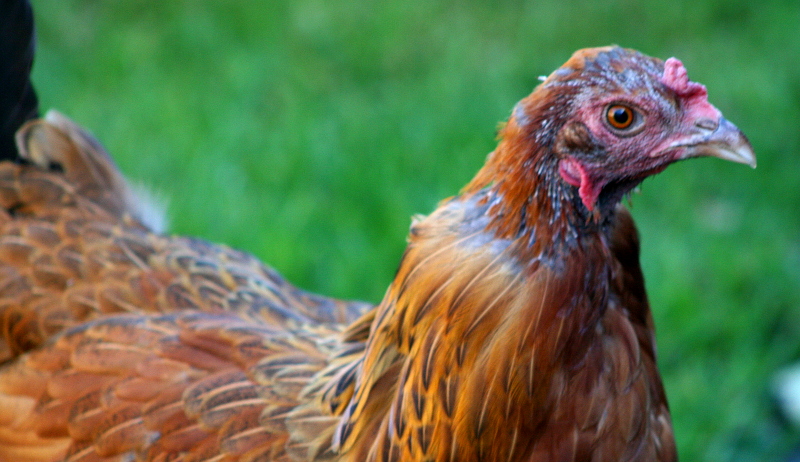
My friend Tom discovered the joys of rearing chickens as a child. Like me, he had grandparents who kept laying hens for fresh eggs. Our grandmothers would task us with collecting the girls’ daily efforts any time we visited. I’m quite positive those venerable ladies had a few good laughs at our expense, especially whenever we ran from the coop with an agitated hen clucking angrily in pursuit.
Tom and I recently reconnected via social media, and I was delighted to hear that he keeps his family tradition alive with his own backyard microflock of Delaware hens. One is even named for his dear old grandmother (I’ve named hens for my grandmothers, and for other family members, too.) Tom speaks quite frequently of his girls, and I wonder at times whether he drives his friends who don’t keep chickens bonkers with his favorite topic of conversation. Luckily for him, I’m always happy to hear his latest henhouse happenings. I therefore was very surprised last week when I received a panicked message from Tom regarding his hens and laying. “What’s wrong with my girls?” he asked. “They haven’t laid in more than a week! Are they sick? Will they be OK? They aren’t going to die, are they?”
Poor Tom. After I asked him a few specific questions—and after I calmed him down—I determined the reason his nests were empty of eggs. If your hens are not producing eggs, there’s a good chance that one of these six reasons are afflicting your flock and its laying process.
1. Molting

Adult hens (ages 1 year and older) lose their feathers every year, usually between September and November. This loss of plumage—called molting—can range from a mild loss and regrowth to a drastic exfoliation that leaves a bird looking like it suffered a chance encounter with a plucking machine. During a molt, all of a chicken’s resources and energy go into the creation of new feathers which will provide warmth during the winter months. Once her plumage has regrown, a hen will resume egg laying as long as she has sufficient daylight for production.
2. Change In Daylight

The chicken reproductive system features one of nature’s most ingenious designs. To increase the rate of offspring survival, a hen’s reproductive system goes dormant during the winter months. This way, newly hatched chicks are not born into bitterly cold conditions. This resting period also allows a hen to recover from the rigors of egg production, which is taxing on a chicken’s body. Once spring arrives and daylight increases—a minimum of 14 hours of light are required to stimulate a chicken’s reproductive cycle—henhouse laying will resume.
3. Advanced Age
As with most females, there comes a point in a hen’s life when she reaches the stage where she no longer produces eggs with the same frequency as she did in her younger days. Instead of laying four to five eggs per week, she might lay one egg per month. Each chicken’s decrease in production differs. Typically, by the time a hen reaches three years of age, she is considered past her egg-laying prime.
4. Improper Nutrition
No creature thrives if it doesn’t receive proper nutrition. A malnourished hen will not produce eggs when her own body is starving for the nutrients necessary for proper health. Producing an egg requires calcium, sodium, vitamin D and protein; check your layer rations’ ingredients to make sure your hens are getting the nourishment they need in order to lay. Don’t neglect clean, fresh water; water is a key component in the production of eggs, and neglecting to refresh your henhouse font even for one day can cause a slump in egg production.
5. Stress

Stress adversely affects laying hens, causing them to discontinue egg production and grow lethargic. It also makes hens susceptible to illness, pecking-order incursions and flock estrangement. Stress has a variety of causes, including sudden changes in weather and temperature, overcrowding, the introduction of new flock members, dehydration, an overactive rooster and predation. Providing your flock with a roomy, predator-proof coop, shady places to rest and plenty of water will go a long way to keep your layers comfortable and relieve stress they might be experiencing. A slow, gentle introduction of new flock members—and separate housing for extra-attentive roosters—can also relieve your girls’ stress.
6. Egg Predation

If you find your nestbox continually devoid of ovoids despite your hens being young, well nourished and exposed to plenty of light, your issue might lie with a predator rather than with production. Eggs are the favorite barnyard treat of snakes, which will swallow their prey whole and leave no trace that an egg was ever laid. Skunks also love eggs, occasionally removing them from the nest but usually eating them in place. Raccoons will remove eggs from nestboxes, but they tend to prefer live prey and will opt for a hen rather than her eggs. Opossum, rats and squirrels will also feast on the fruits of your flock’s labor. Keep predators out by covering all ventilation openings and windows with quarter-inch mesh. Caulk any gaps in the structure of your coop as well, and check your coop floor for holes that allow predator access. An opening one-quarter inch wide is all a snake needs to squeeze into your coop.
Fortunately for Tom, his hens were not suffering from predation, stress or malnutrition. He had purchased them as sexed chicks last spring from a Delaware breeder, and this was their first fall as adults. I asked whether he’d seen an increase in feathers around his yard, and he seemed surprised that I’d know about that. Tom thought that perhaps his girls were fighting amongst themselves, and the feathers flying around represented the aftermath of scuffles. A few days after we spoke, Tom contacted me again, the tone of relief palpable in his message. The mess in the yard was incredible, with discarded feathers covering the grass, the walkway and even the landscaping. His girls—and he—were experiencing their first molt. Case closed.




